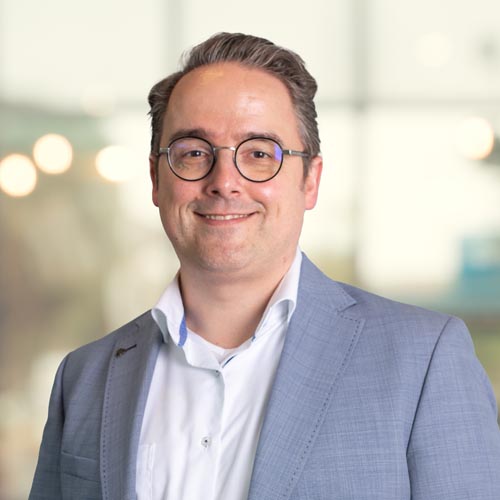
Pascal Buskens

Pascal specializes in designing, manufacturing, characterizing and validating optical materials, coatings and films that interact in distinct ways with sunlight. The materials are mainly used in the photochemical and photoelectrochemical production of chemicals and fuels, as well as for regulating sunlight transmission through windows and for improving the efficiency and aesthetics of integrated solar panels in buildings.
Professorship chair
Nanostructured materials (Hasselt University).
Research area
The guest-professorship ‘Nanostructured Materials’ is positioned at Hasselt University (UHasselt) in the Faculty of Sciences, Department of Chemistry and the Institute for Materials Research (imo-imomec). The professorship is hosted by the research group Design and Synthesis of Inorganic Materials (DESINe), which is headed by prof. dr. M. K. Van Bael and prof. dr. A. Hardy. This research group is experienced in the design, synthesis and characterization of advanced inorganic materials and coatings, mostly metal oxides. The guest-professorship ‘Nanostructured Materials’ bridges the expertise in design, synthesis and characterization of advanced inorganic materials and coatings, to two areas of application which are of strategic interest for TNO and Brightlands Materials Center: sunlight-fueled sustainable chemical processes, and building envelope materials for sustainable buildings. In the field of sunlight-fueled chemistry, the primary focus is on the design of inorganic catalysts for photohydrogenation of CO2 to C1-chemicals and fuels like CH4, CO and CH3OH, and on the design of photoelectrodes and electrocatalysts for photoelectrochemical production of green H2. This field of research can be successfully exploited through coupling of the expertise in preparation of inorganic materials at UHasselt to the expertise in catalysis and plasmonics available from prof. Buskens, supported by further competences and infrastructure available from TNO departments, e.g. Materials Solutions (Eindhoven/Geleen) and Optics (Delft). The focus of this research is the elucidation of the reaction mechanism and underlying physical principles of plasmon catalytic chemical conversions, and the design, preparation and validation of solution processed photoelectrodes for photoelectrochemical hydrogen production. This knowledge can then be applied by TNO for rational optimization of sunlight-fueled chemical processes. In the field of building envelope materials for sustainable buildings, the primary focus is on materials and coatings that provide advanced solar control functionalities to architectural glazing units, and materials and coatings for improving the optical efficiency and/or aesthetics of building-integrated photovoltaic modules. This field of research can be successfully exploited through coupling of the expertise in preparation and in-depth characterization of inorganic materials at UHasselt and the expertise in functional coatings and nano-pigmented polymer films available from prof. Buskens. This is supported by further competences and infrastructure available from the TNO departments Materials Solutions (Eindhoven/Geleen) and Optics (Delft). Multiple products/functionalities are part of this research line, with as current prototypical example thermochromic coatings for solar control glazing, addressing following key research questions: (A) How can dopants effectively be integrated in thermochromic VO2 crystals, to lower the switching temperature from 68°C to 20-30°C with minimum negative impact on the solar modulation? (B) Which balance between transmission in the visible and solar modulation behaviour is achievable for nanoporous thermochromic VO2 coatings on glass, which are produced through packing of VO2 nanoparticles? This knowledge can be applied by TNO and Brightlands Materials Center for rational optimization of solar control windows for architectural glazing. My research contributes closely to the TNO roadmap ‘Sustainable Chemical Industry’ and Brightlands Materials Center.
Top publications
- J. H. A. Schuurmans, T. M. Masson, S. D. A. Zondag, P. Buskens, T. Noël, Solar-Driven Continuous CO2 Reduction to CO and CH4 using Heterogeneous Photothermal Catalysts: Recent Progress and Remaining Challenges. ChemSusChem 2024, 17, e202301405.
- B. Joos, K. Elen, J. van den Ham, N. Meulendijks, P. Buskens, A. Paulus, K. Wouters, J. Manca, J. D’Haen, S. Shukla, B. Vermang, M. K. Van Bael, A. Hardy, Facile Aqueous Solution-Gel Route toward Thin Film CuBi2O4 Photocathodes for Solar Hydrogen Production. Advanced Sustainable Systems 2023, 7, 2300083.
- P. Martínez Molina, N. Meulendijks, M. Xu, M. A. Verheijen, T. den Hartog, P. Buskens, F. Sastre, Low Temperature Sunlight-Powered Reduction of CO2 to CO Using a Plasmonic Au/TiO2 Nanocatalyst. ChemCatChem 2021, 13, 4507.
- L. Calvi, L. Leufkens, C. P. K. Yeung, R. Habets, D. Mann, K. Elen, A. Hardy, M. K. Van Bael, P. Buskens, A comparative study on the switching kinetics of W/VO2 powders and VO2 coatings and their implications for thermochromic glazing. Solar Energy Materials & Solar Cells 2021, 224, 110977.
- F. Sastre, C. Versluis, N. Meulendijks, J. Rodríguez-Fernández, J. Sweelssen, K. Elen, M. K. Van Bael, T. den Hartog, M. A. Verheijen, P. Buskens, Sunlight-Fueled, Low-Temperature Ru-Catalyzed Conversion of CO2 and H2 to CH4 with a High Photon-to-Methane Efficiency. ACS Omega 2019, 4, 7369.
Eindhoven - High Tech Campus 25
High Tech Campus 25
5656 AE Eindhoven
The Netherlands
Postal address
P.O. Box 6235
5600 HE Eindhoven
The Netherlands